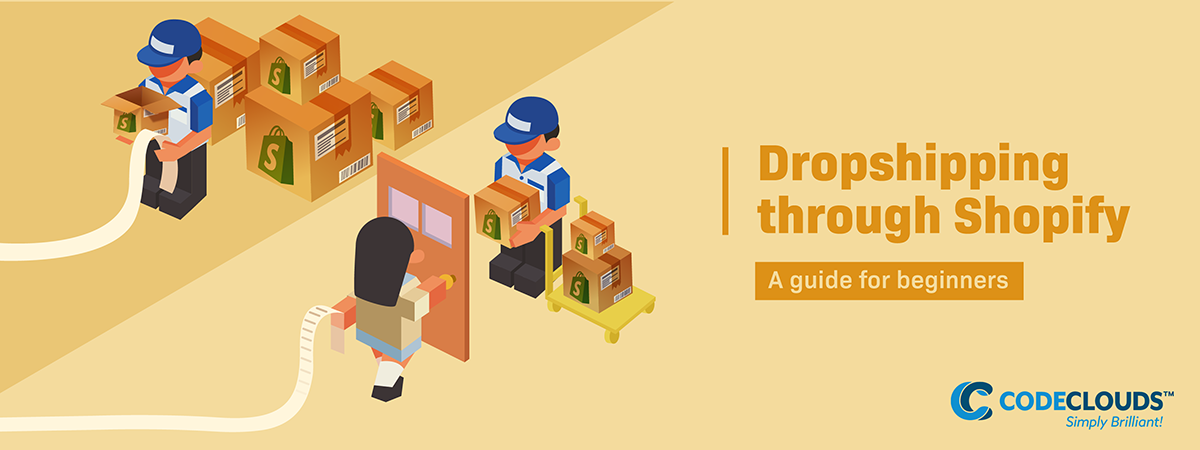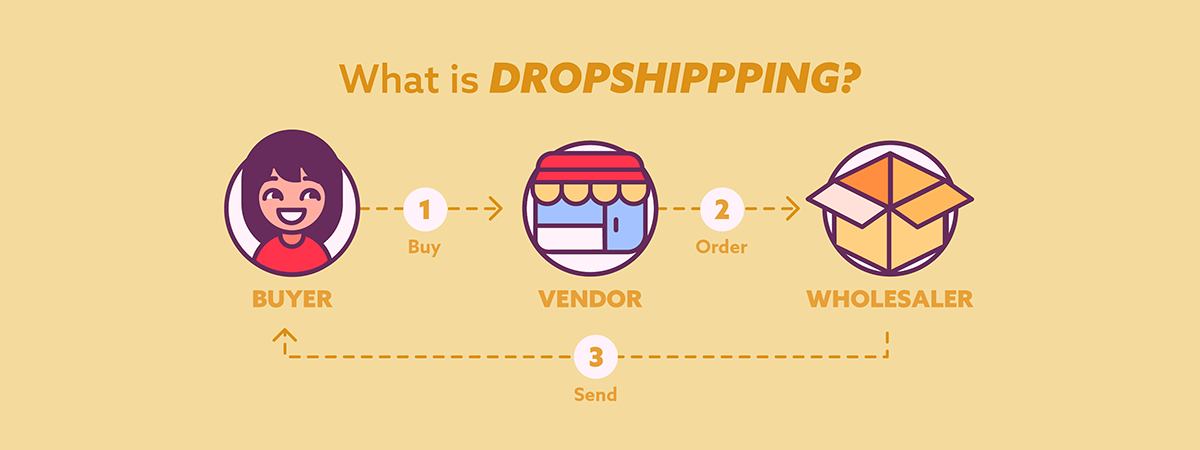Overview
Are you interested in turning your Shopify store into a dropshipping business? Read on and find out how to integrate plugins like Oberlo into your store and get yourself dropshipping today.

We’ve probably all heard about dropshipping at this point, but in case you haven’t, let me get you up to speed. Dropshipping is a sales method where you-the vendor-don’t have any product. Instead, you act as a middleman between buyers and wholesalers: a buyer sends an order to you, and you send it on to the wholesaler or manufacturer. The wholesaler then sends it directly to your buyer, and you take a cut.

The hard truth
Dropshipping seems very appealing to new entrepreneurs. On the surface, it has a low setup cost and a relatively low investment of personal time. However, the truth is trickier than that: in order to be successful, you need to maintain strong relationships with wholesalers and customers while avoiding the many con artists who plague the industry. You need to be discerning and clever to get high-quality products shipped in a way that’s going to keep customers coming back. Some of the big issues experienced with dropshipping are:
- While the costs of dropshipping are low, the margins are also relatively slim.
- It can be difficult to find good wholesalers. Scammers tend to focus on SEO and appearance, while the actual good wholesalers are often not the most tech-minded folks and their websites are outdated and far down the search rankings. Some dropshippers have reported up to 50% customer returns, because the products are low quality or deceptive. This can lead to a high number of chargebacks as well. Considering that not every unhappy customer returns the product, you come to realise how bad some suppliers really are. 84% of dropshippers cite this as their primary issue.
- Customers often don’t understand your business model, which can cause issues: if the wholesaler botches an order, the blame falls on you. You have to sort out a refund or fix, and the supplier-who made the mistake or sent the bad product-doesn’t pay a cent. When that happens, you and the customer both lose out.
- There’s a lot of competition: people see the low cost of entry and think it’s going to be easy. While they tend to also drop out fast, there’s new competitors showing up all the time.
- Very slow delivery times. Normally, items are coming from the closest warehouse to the buyer. Most dropshipped items are coming from China and can take 2-3 times as long to arrive, depending on where in the world they’re going. In an age where delivery times are normally measured in days, dropship delivery times are measured in weeks and sometimes even months.
If you combine all these factors, you start to see why a staggering 90% of dropshipping companies call it quits within 6 months. That’s not as madly high as it seems (research suggests 80% of all companies fail within 18 months) but it’s still notably higher than average.
How do you deal with these problems? Well, a good start is by using Shopify. It’s a cheap, hosted service with excellent support and plugins like Oberlo that connect you with reliable wholesalers. It’s still important to vett a wholesaler yourself, but Oberlo manages to keep out most of the predatory suppliers.
Outside of that, the trick is to be reasonable: a lot of people look at dropshipping as a get-rich-quick scheme and that’s why they end up bottoming out. It’s a business like any other, and needs to be approached as a business: think long-term and focus on gradually building your brand and your customer base. Figure out a reliable supply chain. Set reasonable goals and expectations, and build from there.
What do I sell?
The first thing to do is figure out what sort of products you want to ship. The profit margin issue comes up here: a lot of people set out to sell their passion, but it can be chancy. It’s best to do some market research and figure out whether there’s a market for your passion. Dropshipping isn’t a great model for risk-taking-the initial margins are too small to support bad days. Don’t choose something that bores you, but it’s best to do some market research to figure out where your interests intersect with actual customer demand.
So, you need to pick a product. The first thing to do is check out Google Trends. It’s a simple, powerful analytical tool with a wide range of metrics that will help you figure out exactly what customers are looking for. It has search data going back to 2004 and allows comparison view as well as breakdowns by nation, category, time, and format. You can zoom right in on geographic locations to find out very precise data like-for example-lots of people in WA and OR are searching for ‘Steampunk fashion’ (which isn’t very surprising, if you’ve ever been to Seattle) but that it’s also exceptionally popular in Denver, Colorado.
.png?updated_at=2023-07-26T10:49:04.901Z)
.png?updated_at=2023-07-26T10:48:52.284Z)
Or you could zoom out and find something even more interesting: the term ‘Steampunk fashion’ is not particularly common in US searches, but is very popular in the Southern Hemisphere.
.png?updated_at=2023-07-26T10:49:04.001Z)
While you’re competing with hundreds of other dropshippers in the US, there might be only a handful who specialise in getting these products to Australia. Where in Australia? To the Googlemobile!
.png?updated_at=2023-07-26T10:49:03.207Z)
Adelaide and Hobart, mostly. And there you have a very specific niche that could be a viable dropshipping business: it’s a niche fashion trend, popular in a part of the world that isn’t oversaturated with dropshippers. It’s close to suppliers (Indonesia and China) so shipping costs and delivery times won’t be odious. You’re halfway home: you know who your customers are, and what they want. What next?
You’ll need to use an SEO tool like SEMrush, Moz Pro or Google Keyword Planner to figure out exactly which words people are searching for. Not only will this help you plan your own marketing strategy, it’ll help to flesh out the data from Google Trends. Keyword planners often highlight unexpected connections-a great example is people buying home basketball hoops also searching for sneakers. It makes sense when you think about it (you need the right shoes to play basketball) but it’s the sort of connection a lot of people miss and it can really take your store to the next level.
The Golden Goose of keywords is something that everybody is searching for but nobody is selling. The opposite of this is in high-competition areas like clothing and jewelry where you’re fighting off an army of other vendors just to be seen. ‘Steampunk fashion’ is good, but proper keyword selection might uncover associated terms people are searching for that you never considered; when I put in Steampunk fashion, I found that ‘fashion’ was actually a pretty rare term, and dress, apparel and clothing were much more common searches. I also discovered was also a lot of overlap with the term goth; including gothic fashion and aesthetics in our marketing could be a powerful tool, and it’s one we wouldn’t have discovered without our SEO tools.
If you’re interested in another perspective, Neil Patel’s guide on finding an eCommerce niche is very helpful.
Okay so, Shopify
Once you’ve set up a Shopify account, the first thing you need to do is add Oberlo to it. Oberlo isn’t the only dropshipping plugin available, but it’s officially supported by Shopify and is very careful only to work with trustworthy wholesalers. Once the plugin is set up, go the Products page of your dashboard. Under the More Actions dropdown, you’ll see an option that says Find More Products to Sell.

That’ll take you to Oberlo, where you can search for wholesalers who deal with dropshippers. Remember: be discerning. Dealing with a low-quality supplier is the #1 killer of dropshipping operations; Oberlo is much better than a lot of platforms, but scammers do slip the net sometimes.
From there, you can add products to your storefront like so:
- Find what you’re looking for and click ‘add to import list’.
.png?updated_at=2023-07-26T10:48:49.379Z)
- go to your import list. From there you can change details about the product, though you can do this later and it’s easier to do it through the Shopify interface rather than Overlo. Click Import to Store.
- Inside Shopify, edit the product details as you see fit. You can change text, add images, even play around in the HTML if you really want to. I’d highly recommend you spend some time here: the marketing copy coming directly from wholesalers often lacks personality. There’s a lot of generic text and keyword stuffing-spend some time making things fit your brand better and you’ll see a lot more success.
.png?updated_at=2023-07-26T10:49:04.086Z)
Making it look good
Visual design is a critical part of any online store. Shopify has 10 free themes and 60 more premium purchasable ones, and if you need more you can go to sites like themeforest. Once you’ve selected a theme, you can use the simple drag-and-drop editor to personalise it however you want. You can hire a developer if you really want to take things to the next level, but the editor is designed with ordinary business owners in mind and requires no code knowledge at all.
Shopify has its own stock photo library, called Burst. You can also add your own photos and videos by going Settings > Files and clicking Upload Files, which will let you drop them into the text editor whenever you need them, like so:
.png?updated_at=2023-07-26T10:49:04.720Z)
Putting your products together
Collections are categories you can group your items into. You’ve seen them in online stores before: a music store has a category for stringed instruments, which has a category for violins etc. You can set categories in Shopify by going into the Products menu and finding the Collections subheading. It’s fairly straightforward from there, and once you’ve created a collection, you can tag and organise products to appear under it. You have the option to automate collections but I’d recommend either doing it manually or making sure to curate automated collections yourself-you need to ensure everything is getting sorted into the right place.
I don’t like Oberlo!
There are plenty of other options! Oberlo is the most popular for a reason, but it’s definitely not your only choice. Here are some other Shopify dropshipping plugins to look at:
- Spocket doesn’t rely as heavily on China for suppliers as Oberlo, but still manages to get very competitive prices. It is primarily US/Europe-based and so has shorter shipping times and better pricing for those areas. Spocket also has parcel tracking, which is very important in keeping your customers updated on the status of their purchase.
- Modalyst focuses on big brands. Prices are obviously much higher, but if you want to ship genuine Calvin Klein products, this is where you go.
- Inventory Source is quite stripped-down but is absolutely free. If you want a simple choice, this is it. I’m not sure how well-vetted their suppliers are, so please use your own discretion.
- Aliexpress now have their own Shopify dropshipping plugin. The UI is a bit overengineered and the pricing structure isn’t the clearest, but it has excellent support services and a lot of people swear by it. Your stock here is almost exclusively coming from China.
- Printful lets you dropship custom printed items like t-shirts or mugs. This is a competitive area but a very popular one, and worth considering if you want to ship items with a more personal touch.
What now?
Remember to set reasonable expectations, and good luck! A lot of people hopped onboard in ’16-17′ hoping to get rich overnight, and most of them are gone now, but their failures linger in the public consciousness. A lot of them were lax about picking suppliers, and ended up getting a reputation for defective or misleading products. Dropshipping can be extremely lucrative if you’re willing to put in the work: find reliable wholesalers, ship the right products, make sure your site looks good, and work diligently to build your brand. A unique business opportunity is still a business. It will take time and effort to build reputation and relationships, but it can really pay dividends.
In summary:
- Use Google Trends and keyword tools to pick a good niche
- Be sure to check your supplier’s reputation, and be on the lookout for scammers
- Use Shopify’s Oberlo plugin to add products directly to your story
- Use Shopify’s drag-and-drop interface to customize your store
- Treat dropshipping like any other business

If you feel like you want more help personalizing your Shopify storefront, don’t be afraid to talk to the experts. Here at CodeClouds, we have a team of Shopify developers as well as branding experts to help you build your brand. Shopify’s drag-and-drop interface is good for business owners who don’t know code, but a team that can code can get under the hood and take your store to the next level. Get in touch with us and hire expert Shopify developers today!
Share this article
224 reads
Similar Reads








